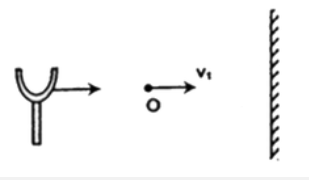If v1andv2 are the frequencies of two turning forks, then beat frequency is
v1v2
v1+v2
v2v1
v1−v2
The correct Answer is:D
To find the beat frequency when two tuning forks with frequencies v1 and v2 are struck, we can follow these steps:
1. Understanding Beat Frequency:
The beat frequency is the result of the interference of two waves with slightly different frequencies. It is perceived as a fluctuation in sound intensity.
2. Formula for Beat Frequency:
The formula for calculating the beat frequency fbeat is given by:
fbeat=|v1−v2|
Here, v1 and v2 are the frequencies of the two tuning forks.
3. Applying the Formula:
To find the beat frequency, we take the absolute difference between the two frequencies. This ensures that the result is always a positive value, as frequency cannot be negative.
4. Conclusion:
Therefore, the beat frequency is:
fbeat=|v1−v2|
Final Answer:
The beat frequency is |v1−v2|.
---
The beat frequency is the result of the interference of two waves with slightly different frequencies. It is perceived as a fluctuation in sound intensity.
The formula for calculating the beat frequency fbeat is given by:
fbeat=|v1−v2|
Here, v1 and v2 are the frequencies of the two tuning forks.
To find the beat frequency, we take the absolute difference between the two frequencies. This ensures that the result is always a positive value, as frequency cannot be negative.
Therefore, the beat frequency is:
fbeat=|v1−v2|
The beat frequency is |v1−v2|.
Topper's Solved these Questions
- WAVESBOOK - PHYSICS WALLAHCHAPTER - WAVESEXERCISE - NEET PAST 4 YEARS QUESTIONS
15 Videos
- WAVESBOOK - PHYSICS WALLAHCHAPTER - WAVESEXERCISE - NEET PAST 4 YEARS QUESTIONS
15 Videos
- WAVE OPTICSBOOK - PHYSICS WALLAHCHAPTER - WAVE OPTICSEXERCISE - Neet Past 5 Years Questions
16 Videos
- WORK, ENERGY AND POWERBOOK - PHYSICS WALLAHCHAPTER - WORK, ENERGY AND POWEREXERCISE - NEET Past 5 Years Questions
16 Videos
Similar Questions
There is a source of sound (a tuning fork) moving towards a reflecting wall will a speed of 30ms−1. The velocity of the sound in air is 330ms−1and the frequency of the tuning fork is 600 Hz. The observer is between the source and the wall and is moving with some velocity V1 towards the wall. The beat frequency heard by the observer is 4 Hz. If the tuning fork is waxed, the frequency beats heard by the observer becomes 3 Hz. If the new frequency of tuning fork is k then k/50 is

View SolutionA set of 10 tuning forks is arranged in series of increasing frequency. If each fork gives 3 beats with the preceding one and the last fork has twice the frequency of the first, then frequency of the first tuning fork is
View Solution
Knowledge Check
The frequency of tuning fork A is 2% more than the frequency of a standard tuning fork. The frequency of a tuning fork B is 3% less than the frequency of the same standard tuning fork. If 6 beat/s are heard when the tuning fork A and B are excited , then frequency of A will be
A120HzB122.4HzC116.HzD130HzA set of 28 tuning forks is arranged in a series of decreasing frequencies.Each fork girves 4 beats per second with the preceding one and the frequencies of the first forks is an octave of the last.The frequency of the first fork in Hz is
A220B216C212D208When a guitar is sounded with a 440 Hz tuning fork, a beat frequency of 5 Hz is heard. If the experiment is repeated with a tuning fork of 437 Hz, the beat frequency is 8 Hz. The string frequency (in Hz) is :-
A445B435C429D448
Two tuning forks A and B give 4 beats/s when sounded together. If the fork B is loaded with wax 6 beats/s are heard. If the frequency of fork A is 320 Hz, then the natural frequency of the tuning fork B will be
View SolutionThe frequency of fork A is 3% more than the frequency of a standard fork where as the frequency of fork B is 3% less. The fork A and B produce 6 beats per second. The frequency of standard fork will be -
View SolutionThe frequency of fork A is 3% more than the frequency of a standard fork where as the frequency of fork B is 3% less. The fork A and B produce 6 beats per second. The frequency of standard fork will be -
View SolutionWhen a guitar string is sounded with a 440 Hz tuning fork a beat frequency of 5 Hz is heard if the experiment is repeated with a tuning fork of 437 Hz ,the beat frequency is 8 Hz .The string frequency (Hz ) is
View SolutionTwo tuning forks produce 4 beats per seconds when they are sounded together. Now both the forks are moved towards the observer at same speed (u). The beat frequency now becomes 5Hz. If the observer also beings to run with speed u towards both the forks, then beat frequency is.
View Solution
